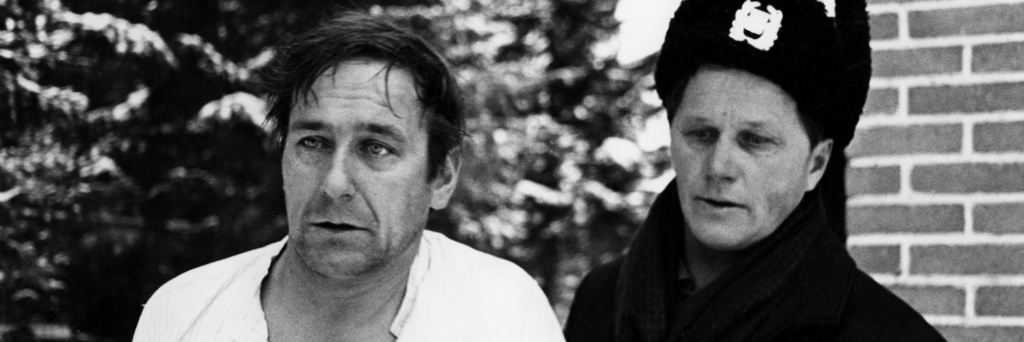Thanks to the Criterion Channel and Martin Scorsese’s World Cinema Project, I was exposed to a miniseries that I had never heard of and a talented writer/director/actor buried in Finland’s cultural history. It was also based on a crime that, as sad as that is, while somewhat common in the United States, was beyond comprehension in Finland in 1969. It caught the eye of one of the country’s most talented filmmakers because he had known this life and could have easily fallen into the same trap if it weren’t for his passion for drama.

Real Life Shots
Eight Deadly Shots is based on the tragic events of March 7, 1969, when four police officers were shot dead in a tiny village called Pihituputa. Tauno Pasanen, a farmer with a family, flew into a drunken rage, another in a string of cases that forced his family to flee for their safety and call the police. The officers went to calm Pasanen rather than arrest him, but the still-intoxicated Pasanen responded to their presence by firing his rifle from his home at each of the four officers. It lasted a minute before he told his neighbor to call the police and “pick up those carcasses.” Pasanen later said he had no motive or reason to shoot the police.
The crime shocked all of Finland and the four officers were buried together in a time of national mourning. Meanwhile, Pasanen was convicted and sentenced to life imprisonment for the quadruple homicide. His background was scrutinized and exposed a very horrible reality: rural poverty where Pasanen and thousands lived was rife and the use of illegal moonshine sold supplemented incomes. People like Pasanen drank their moonshine as a way to cope, leading to deadly results. Someone familiar with that life was Mikko Niskanen, who grew up in similar circumstances before attending drama school.

Shooting Shots Of A Snowy Loneliness
Niskanen found success in his home country with films including The Boys (1962) and Under Your Skin (1966), winning Finland’s version of the Oscars, the Jussi, six times for Best Director. He was a major star already when he decided, against the wishes of many, to create a fictionalized version of the killings. The budget for his four-part film (it was planned to be 80 minutes) was less than what he wanted, and after almost killing his cinematographer during the recreation of the shooting, the studio was ready to end the project. Niskanen was able to convince them otherwise and finished the film on time.
In 1972, three years after the real-life tragedy, Eight Deadly Shots was released to universal acclaim. The story follows Pasi, married with a wife and kids trying to make ends meet while working on the farm, but he falls more and more into debt as crops begin failing. With his fellow neighbors, Pasi makes moonshine to sell, but is harassed by the police who disrupt their work. Taking to moonshine personally, he begins arguing with his wife on what are small issues, but causes more and more anguish before a drunken fight turns into a violent event.
The miniseries is a piece of social realism, shooting on location and using non-professional actors with some professional ones to capture a more realistic portrayal. Niskanen even followed a method acting tactic by drinking like his character and slept in similar accommodations which affected his sleep and normal functions while working. The crew was small and Niskanen would shoot some scenes alone while members of the crew made the drive up from Helsinki to a tiny town in central Finland. Sound mixing in the elements was found to be a lot harder due to continuous winds which interrupted the filming. It was, like Tauno Pasanen, made under the influence when Niskanen fired live rounds – not blanks – which almost caused production to be totally scrapped. He was forced to shoot the rest in the controlled environment in Helsinki where he could be watched.
Upon release, it was universally acclaimed in Finland. Among those who watched the film was then-President Urho Kekkonen with Niskanen at a private screening and praised the film. A copy was shown to Pasanen in prison and said of it, “This is so true that it makes me laugh and cry at times. That is how life was back there. My fate in life was so accurately portrayed that it is like ripped from my soul.” Those who spoke negatively of it were families of the deceased police officers who saw it as being too sympathetic to the man who was a mass murderer.

A Twist Ending
Years after the killing, Pasanen and others wrote letters of support for clemency as people began seeing the acts caused by circumstances rather than outright evil. In 1982, Pasanen was given a pardon by President Mauno Koivisto and moved to a new town to be closer to his ex-wife, who divorced him while he was imprisoned, but remained close. The home where they lived and the scene of the massacre had been demolished. Per all accounts, things were fine for Pasanen, despite strong protests by law enforcement that a multi-cop killer had been freed and neighbors of their new town were weary to have Pasanen around them.
Then, in 1996, an intoxicated Pasanen called the police to his home. After a drunken argument, Pasanen had strangled his ex-wife to death, but had no memory of the killing. Understandably, this brought back memories of his first deadly killings and anger as to why such a convict was given freedom despite the heinousness of his actions. Pasanen only served seven years for manslaughter and, as of May 2024, is still alive and living very quietly back home near his adult children.
Follow me on Twitter: @brian_cine (Cine-A-Man)





